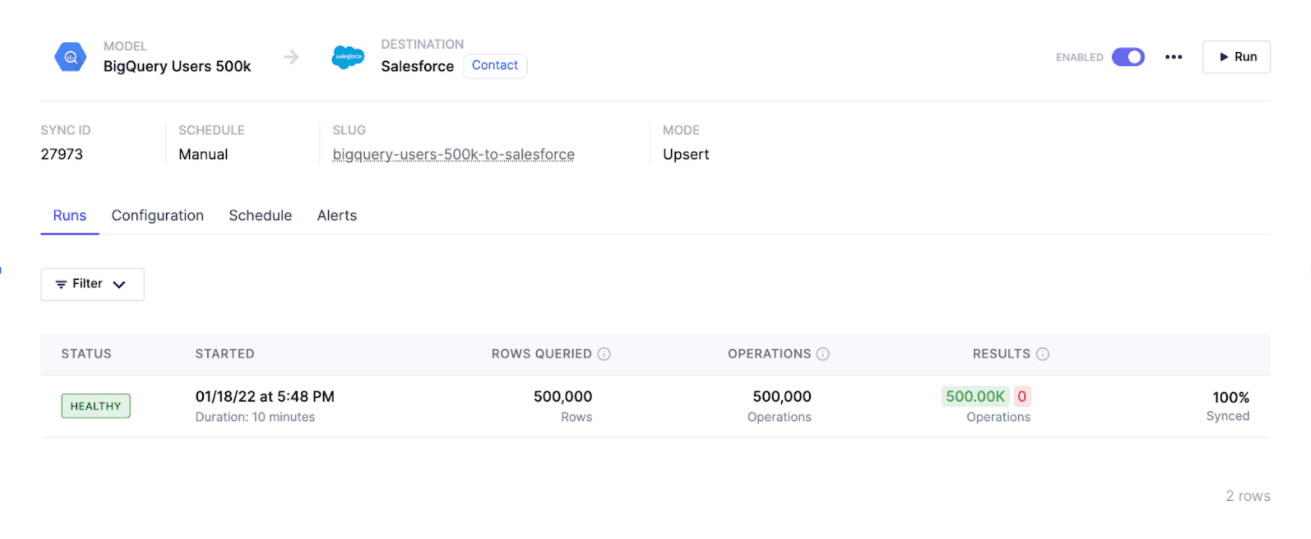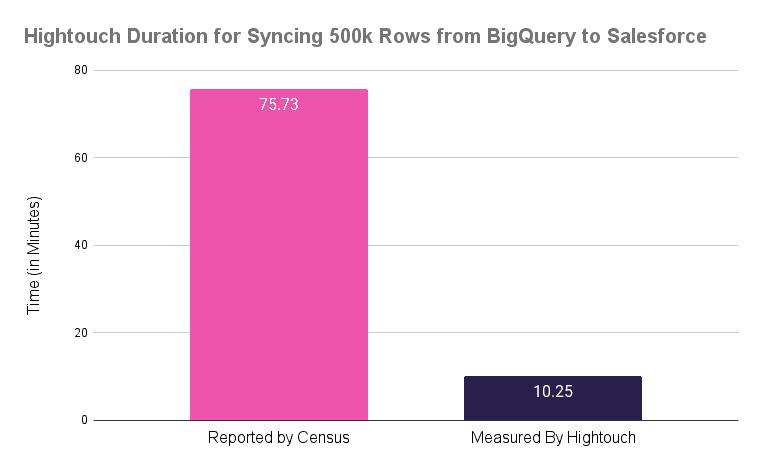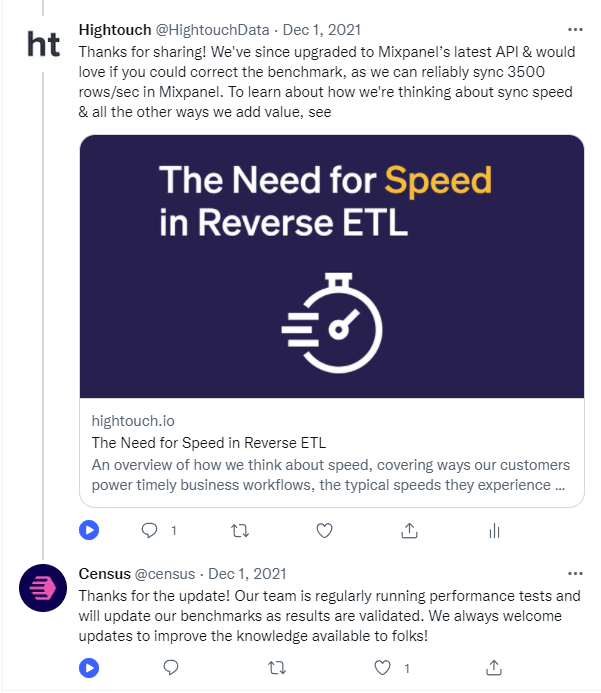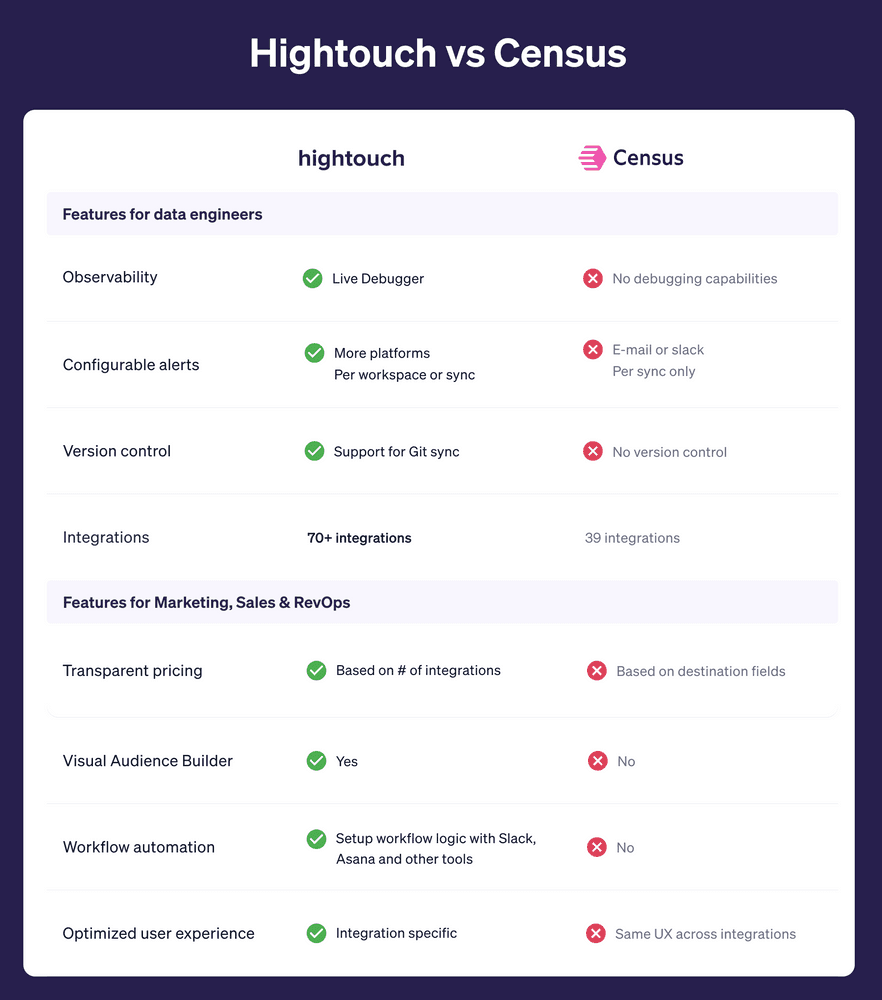As the Reverse ETL category has grown, it’s become increasingly competitive. At Hightouch, we’re big advocates for competition, as we believe competition up-levels the quality of the market and all solutions available to customers.
That being said, in the presence of competition, we find that time and time again, early-stage startups start grasping for straws for the sole purpose of differentiation and lose focus on what’s ultimately most important— driving business value for their customers.
Startups die from suicide, not homicide - Paul Graham
The most recent example of this in the Reverse ETL category is competitive benchmarks. Recently, one of our startup competitors in the Reverse ETL space, Census, posted a series of articles claiming that they can sync data from the data warehouse to SaaS destinations faster than Hightouch.
We believe that benchmarks like these are not only unproductive but are also inaccurate and misleading for marketing purposes. Our goal is to help companies make fully informed decisions when evaluating their Reverse ETL tool and understand the nuances of speed in real-world scenarios. We hope this allows all vendors in the Reverse ETL category to continue focusing on what really matters— innovating on product and driving business value for our customers by helping them activate their data.
Fact Check: How Fast Is Hightouch?
Census posted a benchmark showing that they can sync data to Salesforce 486% faster than Hightouch. The magnitude of these numbers caught our team’s attention so we decided to run the tests ourselves.

As shown above, we synced 500,000 records in 10 mins and 15 seconds. That’s 813 records per second and puts Hightouch’s Salesforce sync speed above Census by 27%. These benchmarks are up-to-date as of January 29th, 2022 but may become even better over time, as we're continuously improving our destinations and platform every week.
We found similar discrepancies across their reports. The Census sync speeds below are as reported by their own benchmarks.

In the below chart, you can see the discrepancy between the speed that Census reported that Hightouch has compared to the actual speed we measured with the same dataset and parameters. The above benchmarks are from Jan 28, 2022.

If you’re skeptical, we encourage you to run the benchmark yourself. You can sign up for our free plan. You can find the data set we used here.
In reality, there are a number of different factors:
- Region of your data warehouse. This affects latency of data transfer
- Resources allocated to the data warehouse
- API credits available in the destination
Case #2: Misleading Benchmarks - Hightouch vs. Census on Mixpanel
In Census’s following blog post titled “Census 44x faster than Hightouch for event syncs,” the company portrays Hightouch to be much slower at “large-scale event syncs.” We found that the root cause for this example of a slow sync time came from a very (and I mean, very) specific feature of one of our 250+ destinations that simply needed an API update.
A fix was shipped within 2 hours of a customer reporting the issue. The issue we corrected was that Hightouch’s Mixpanel integration was released before Mixpanel’s new bulk import API, and we had not updated our integration to use the latest API, which was ~50x faster. After releasing the change, the speed of our Mixpanel syncs are now at par with Census’s.
The customer ultimately chose Hightouch for data activation, emphasizing that the speed at which we resolved their report only solidified Hightouch as their vendor of choice.
Census’s benchmarks are for competitors, not customers
While this series of competitive benchmarks are advertised as a commitment to transparency to customers, we feel the way they’re presented indicates the opposite.
We’re starting with large-scale event sync workflows, arguably where speed and scale matter the most.
Their blog post implies that Hightouch is slower for “large-scale event syncing” use cases. That’s pretty misleading, as the discrepancy in speed is just one use case of one of our 250+ destinations that was resolved within 2 hours of a customer report.
We invite Hightouch and any other reverse ETL providers to share updated benchmarks so we can collectively push this category of data tooling to new heights.
On top of that, Census’s blog states that they welcome vendors to share updated benchmarks, but despite reaching out multiple times, Census still hasn’t updated their public benchmarks and continues to share these outdated materials in head-to-head sales.

Educating the Buyer: What Should You Make Of Reverse Etl Vendor Benchmarks?
There is no magic. It’s all in the details — Walt Disney
As a technologist, when I see benchmarks as extreme as 44x or 87x faster, the sirens in my head go off. Either the technologies are fundamentally different or the benchmarks are misleading. It’s as simple as that.
Reverse ETL isn’t rocket science. The use cases in these competitive benchmarks are quite straightforward. There’s nothing novel in either Hightouch or Census’s underlying architecture to drastically speed up a simple batch sync of data from your warehouse to SaaS tools, and it’s only disingenuous to imply so in either direction.
Fundamentally, Reverse ETL syncs are bottlenecked by the speed at which the destination APIs can accept data. Hence, max speeds between the tools are comparable.
Closing Thoughts
Misleading benchmarks are nothing new. There are similar debates between Snowflake and Databricks and outside of the data space, Intel and Apple regarding M1 chips.
We understand the need for speed in Reverse ETL and are committed to serving the most real-time use cases. If there’s any case that we’re not up to the performance requirements of our customers’ use cases, just reach out– we’re all ears and would jump on it.
For more direction on how to compare Reverse ETL tools, check out our Hightouch vs. Census page or ask our sales team for customer references.

While there’s not much room to differentiate in speed for the most basic Reverse ETL use cases, the market is always forcing us to push forward the boundaries of technology in the space.
We like to be uber-transparent about our roadmap. This is what helps top companies like Warner Music Group, Auto Trader, and Flickr take a bet on Hightouch as the industry leader in such an early space. Most of the work our team is doing isn’t related to sync speed, but there are some really interesting initiatives we’re working on that push what’s possible here.
Here’s a few examples -
- Real-time event forwarding: We have a private beta for syncing data from streaming sources like Kafka, Kinesis, Materialize, Segment, and webhooks.
- Optimized delta calculations: Hightouch automatically only syncs changed data to destinations. This process can be sped up for event syncs.
- Multi-region: Today, Hightouch can store data in your own cloud (AWS, GCP, Azure) and region of choice, but all data is transiently processed in the US. We’re deploying our Reverse ETL pipelines across the globe so if your warehouse or destination (e.g. email server) is in a non-US region, your data doesn’t have to go around the world and back. This has both speed and compliance benefits.
We founded Hightouch with a mission to help our customers activate their data to drive business outcomes. Regardless of the competitive environment, our commitment to our customers is to stay laser-focused on exactly this.















